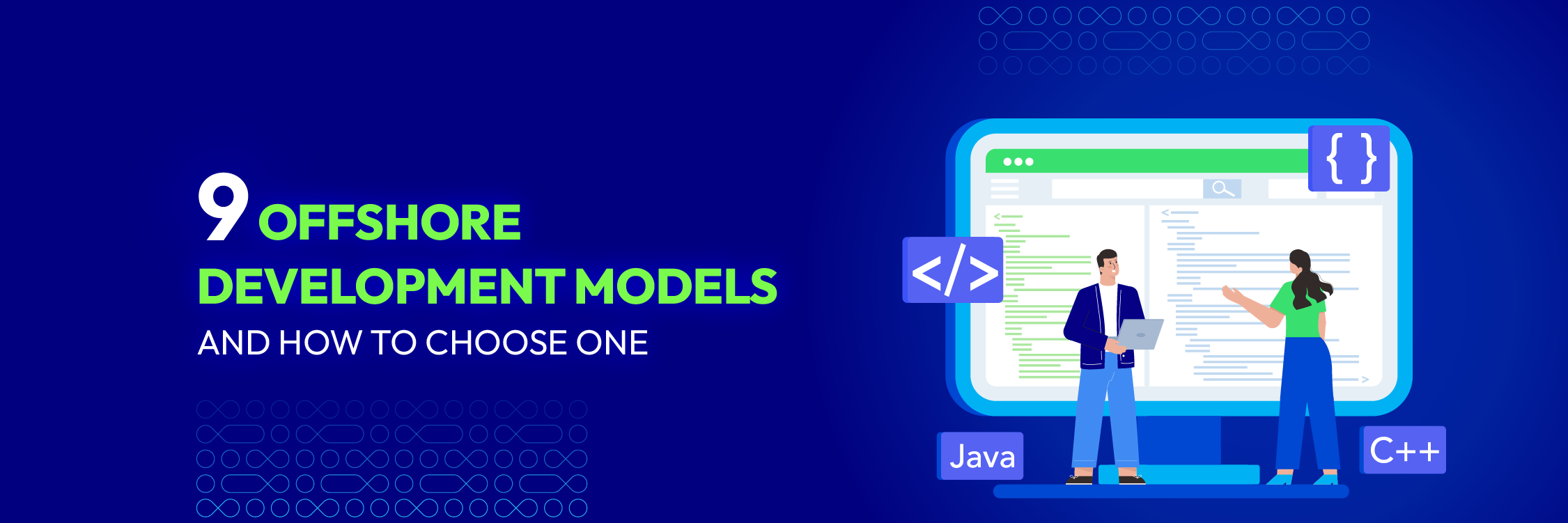Offshore development model: 9 types and how to choose one
Summer Nguyen | 12-16-2023

Offshore software development has been gaining traction in recent years, as companies seek to leverage global talent and reduce costs. However, selecting the right offshore development model for your business can be challenging.
When choosing an offshore development model, businesses must consider various factors such as budget, communication, timeline, and geography. Fortunately, offshore development can help overcome these limitations and enable companies to achieve their desired performance outcomes.
In this blog post, we will explore 9 common offshore development models and guide how to choose the best one for your business needs. If you’re looking to implement offshore software development but are unsure where to start, this guide will get you started. Let’s get started!
What is an offshore development model?
Offshore development models, or engagement models, involve various methods of collaborating with remote software developers or partners. It specifies the responsibilities, tasks, and payment methods for both parties.

Picking the right engagement model is critical since it has a major impact on the outcome of your project. Making the wrong decision initially might lead to several issues later in the development process.
One thing to keep in mind is that there is no one-size-fits-all approach to choosing an offshore development model. Your project’s complexity and partnership approach will determine the most suitable engagement model for your organization.
Benefits of choosing the right offshore development model
Selecting the appropriate offshore development model can provide significant benefits for businesses. Here are some of the benefits that you can expect:
- Access to a broader pool of skilled talent: Businesses can access a more extensive range of skilled professionals when choosing the right offshore development model. You can select specific software experts with the required knowledge and skills for your project.
- Cost savings: Hiring offshore developers can be cost-effective, as they typically have lower living expenses. This allows businesses to pay lower salaries. As a result, companies can afford to hire skilled developers at a more affordable cost, significantly reducing operational and overhead expenses.
- Improved efficiency: By leveraging the expertise of offshore development partners, businesses can improve their overall efficiency and productivity. Offshore development also allows companies to focus on their core business processes, which will double the efficiency of the work.
- Faster time-to-market: With a larger team of developers working on the project, offshore development can accelerate and speed up time-to-market development.
- Increased flexibility and scalability: You may need to scale your operations as your company expands. Offshoring software development allows you to swiftly and efficiently increase team capacity when needed.
9 offshore development models
There is a large array of offshore development models for businesses to choose from. The way offshore development models are categorized is also different, which may be confusing for many business owners. We will take a look at 9 offshore development models which are classified by business models, levels, and services.
Offshore development model by Business models
Business models for software development outline how companies offer value to their clients, including the services they provide and how they receive compensation. Each business model is distinct and has its own advantages and disadvantages. The benefits of offshore development outweigh certain myths surrounding it and the services it provides.
Any software development company’s employees must be well-versed in the offshore development process. Businesses can now outsource projects by three models to make things easier and more convenient for themselves:
Fixed Priced model
The Fixed Price model is the most prevalent among the various engagement models in the software development industry. This model involves determining and agreeing upon the project cost and timeline before starting the project.

The company and the developer meticulously plan out the project scope in advance, utilizing specific project requirements, budget, and estimated engagement duration.
This model best suits for small and medium-scale enterprises and when there is a clear understanding of project goals and requirements. The Fixed Priced offshore development model will work best for short-term projects which last only a few months or less.
Advantages of the Fix Priced model:
- Clear project scope and requirements
- Predictable costs and budget
- Less monitoring with regular progress updates and clear milestones
- Clarity on the deliverables
- Enhanced collaboration and trust with development partners
Disadvantages of the Fix Priced model:
- Limited flexibility and no room for modification
- Time-consuming planning and the delay in the start of the work
- Unforeseen changes in the project
- Risks of miscommunication or misunderstandings between parties at the beginning of the project
The fixed price engagement model typically has a higher project success rate due to the development team’s focus on improving their processes for consistency, predictability, and optimal performance. This enables the project to be delivered within the agreed-upon timeline, at a low cost, and on schedule.
Dedicated Development Team model
A dedicated Development team is a team-based offshore software development model widely used by businesses. The development team is responsible for the project’s success and is the primary source of all technologies, architecture, and produced code.

A dedicated team typically focuses on one project at a time, making it an ideal choice for releasing large-volume products or systems. This model acts as a virtual team, supporting the client’s in-house team of developers and employees.
The Dedicated Development Team is reliable and can significantly contribute to the project’s success. They understand how offshore outsourcing services can help the client in terms of project development, future scope of work, and business profitability.
Advantages of the Dedicated Development Team model:
- Cost-effective and the ability to scale the team up or down
- High level of control over the project’s scope, budget, and timeline
- Long-term partnerships between the client and the offshore team
- Efficient communication throughout the project
- High confidentiality and protection of Intellectual Property Rights
Disadvantages of the Dedicated Development Team model:
- Higher upfront costs due to handpicked experts and additional training or onboarding
- Limited flexibility as the project requirements change
- Cultural differences in communication and work styles
Time & Material model
The Time & Materials model is based on accurate estimations of the project’s execution time and resources required. The project’s expense is directly proportional to the efforts needed to complete the project.

This model is more flexible than the Fix Priced model as the developers’ charge is determined by competence and time (generally on an hourly rate basis).
The Time & Material model is particularly advantageous for high-quality projects that are complex and subject to frequent changes during execution. This paradigm is excellent for ongoing development projects with ambiguous scope and requirements.
In situations where you require work but are uncertain about the duration or scope of the project, it’s advisable to avoid making wild guesses. Instead, the Time & Material (T&M) model can be better. This model offers flexibility, allowing you to adjust the project’s scale and budget during development.
Advantages of the Time & Materials model:
- Cost effectiveness
- High flexibility for project or budget modifications
- Better project tracking and control
- Higher level of quality assurance and continuous improvement
- Support of the Agile methodology
Disadvantages of the Time & Materials model:
- Lack of predictability of the project’s scope and budget
- Lack of certainty of the timely delivery of the project
- Higher level of client involvement during the lifetime of the engagement
- Lower cost control
- Hard to manage expectations due to no milestones and marked progress during the project
Offshore development model by Levels
When selecting a partner relationship, the first consideration is the level of control that the client desires or can exert over the contractor’s work.
The level of coordination between both parties determines the level of access to resources required to successfully complete the project. Based on these factors, the types of cooperation are categorized into the following three models:
Low-level Outsourcing
In a low-level offshore software development model, the product management remains with the client company, while the development and quality assurance processes are shared with the outsourcing team.

In this model, the outsourcing team is responsible for coding and software delivery, while the client typically handles manual testing and test development.
Advantages of the Low-level Outsourcing model:
- Cost-effective as it involves low-level tasks
- Better flexibility as it allows businesses to maintain control over product management
- Access to an extensive specialized expertise
Disadvantages of the Low-level Outsourcing model:
- Potential for misalignment between the client and the outsourcing team’s vision or goals
- High dependence on the outsourcing team
- Limited control over development and QA processes
High-level Outsourcing
Another offshore development model is the High-level Outsourcing model. In this model, product management remains with the client company, as does the QA team responsible for designing and performing tests under in-house supervision.

However, project management, solution design, and test design are passed to the offshore development center. The remaining processes are still under in-house supervision.
Architect-level software engineers control the outsourced processes, with developers approving code design and interpreting PRD and architect-level testers approving tests and interpreting PRD.
Advantages of the High-level Outsourcing model:
- Greater control over development and QA processes
- Improved efficiency by allowing the in-house team to focus on core tasks
- High flexibility and scalability to scale up or down the development
- Cost-effective as it involves outsourcing higher-level tasks that require specialized expertise
Disadvantages of the High-level Outsourcing model:
- Complex coordination between the client company and the offshore development center
- Potential for misalignment and delays in the development process
- High level of dependence on the outsourcing team
Complete Technical Outsourcing
The last offshore development model categorized by levels is the Complete Technical Outsourcing model. Technical outsourcing involves hiring specialists to provide technical guidance to businesses.
Offshore development teams are experts in offering various technical services, from developing simple one-page websites to complex eCommerce sites with multi-functionality.

Offshore development is beneficial when businesses face uncertain technical requirements that demand a dedicated team for custom software development.
Offshore development centers may be located remotely, or businesses may opt to collaborate with offshore developers. These teams are reliable and among the best in the industry, providing businesses access to specialized expertise and technology.
Advantages of the Complete Technical Outsourcing model:
- Access to specialized expertise that might not be available in-house
- Reduced overhead costs associated with maintaining an in-house technical team
- Greater control over development processes
Disadvantages of the Complete Technical Outsourcing model:
- Security risks as sensitive business information are provided to the offshore team
- Limited in-house knowledge as all technical processes are outsourced
- Communication challenges and cultural differences
Offshore development model by Services
When discussing offshore outsourcing, it is essential to consider the classification of service models. The choice of service model depends on the project’s size and complexity and can significantly impact project success.
Here are 3 main offshore development models by services:
Project Based
The offshore software development model is often used for projects with well-defined requirements and defined timeframes. This model is a viable option for larger engagement scopes beyond one-time projects.

The project-based approach is particularly suitable for companies with irregular, one-off, and pilot projects of low to medium complexity with clearly defined requirements and deliverables. Many of these projects evolve into long-term relationships and result in establishing a dedicated development center.
Advantages of the Project Based model:
- Faster project completion times
- Access to specialized expertise and technology
- Cost savings and no incurring overhead costs
- Flexibility in project execution
Disadvantages of the Project Based model
- Potential issues with project deliverables
- Challenging quality control
- Communication challenges and cultural differences
Offshore Development Center
The Offshore Development Center is a widely-used offshore development model that can bring profitability to businesses. This model is ideal for companies that want to reduce costs without compromising quality or available development resources.
To achieve this goal, the customer selects a software development company to form a team of experienced offshore developers from the contractor’s pool of resources. These dedicated offshore developers are guaranteed to work only on one project at a time and are fully managed by the customer.
This framework allows the customer to ensure that the team meets project requirements and can deliver the required functionality on time.
The offshore development center model is an excellent choice for clients familiar with their project development’s complexities and challenges. They are willing to invest in long-term business relationships to overcome them.
With a dedicated offshore development team that represents all the required technologies, architecture, experience, and knowledge, businesses can ensure the quality and success of their projects.
Advantages of Offshore Development Center:
- Developed long-term partnerships
- Greater control over development processes than with other outsourcing models
- Access specialized technical expertise and technology
- Better flexibility and scalability
Disadvantages of Offshore Development Center:
- A high initial investment in setting up the dedicated offshore team
- Data security concerns
- Not suitable for businesses with short-term or sporadic development needs
Staff Augmentation
Staff augmentation is a straightforward offshore development model. It allows companies to augment their in-house staff with offshore developers who become a fully-fledged part of the team.

With this model, the outsourcing contractor’s responsibilities are usually limited to routine technical tasks, such as implementation and prototyping. The vision for the product and decision-making scope of the augmented development resources team are limited, which may not encourage them to improvise.
Staff augmentation is attractive for businesses looking to augment their in-house development resources with specialized technical expertise.
Advantages of the Staff Augmentation model:
- Direct control and management over offshore teams
- Predictable outcome
- Quicker time to market
- Cost savings with a low possibility of overhead costs
- Ability to engage with the developers for support
Disadvantages of the Staff Augmentation model:
- High level of control and direct management of the augmented staff
- Limited vision and decision-making scope
How to choose the right offshore development model for your business?
Choosing the right offshore development model is a headache for many business owners. It’s important to remember that there is no best development model. What matters is that the model you choose suits your business needs and goals.
Here are some factors to consider before choosing an offshore development model for your business:
- The project stage. Choosing the right software development model for your business depends on several factors, such as the project stage. If you are still in the ideation stage or have a general idea of what you want but no clear picture of how to go about it, a fixed-price or time and materials (T&M) engagement model may be suitable.
- Size of your team. Outsourcing may be a helpful solution if you have a smaller team that is already stretched thin but needs to complete a short-term project.
If your team is a blank slate, assembling an entire team with the required skill set and expertise can be challenging. In this case, Dedicated Development Team can be an excellent option.
- Project scope. If you are developing a market-ready product, you may require a long-term development duration. The Project-based model or Dedicated Development Team model can help you with that.
- Skillset of your workforce. A dedicated development team may be an excellent option if you require a specific skill or expertise to handle a project not available in-house. This model allows businesses to access a wealth of specialty talent overseas, which may not be locally available.
- Your budget size. If you have a tight budget, consider using Fix Priced model, Time & Material model, or Dedicated Development Team. They are cost-effective and save you a lot of time and money.
Why is Mageplaza a good choice for offshore development?
When considering offshore development models, Mageplaza is a great choice for businesses looking for a reliable and experienced partner. With nearly ten years of experience, Mageplaza can provide businesses with access to specialized expertise and technology.

Here are the benefits you can get when outsourcing offshore development to Mageplaza:
- In-depth Expertise: Mageplaza is experienced in eCommerce solutions for Magento, Shopify, and Shopware platforms. With a team of experts who are well-versed in the platforms’ features, customization options, and best practices, Mageplaza offers top-notch services tailored to the specific needs of its clients.
- Affordable Pricing: At an affordable rate starting from just $15 per hour, our service provides exceptional value for your investment. We offer various engagement models tailored to your specific requirements and budget.
- Dedicated Support: Our team of experts provides continuous technical support to clients, ensuring that any issues that may arise are promptly addressed. You can focus on growing your brand, confident in the knowledge that our professionals will take care of any technical complexities.
Get ready to grow your business with Mageplaza and gain a competitive edge in the market. Contact us today for more information!
Conclusion
Selecting the right offshore development model is critical to the success of your business. Considering factors such as project stage, budget, and required skillset, you can choose a development model that aligns with your needs and goals.
From staff augmentation to dedicated development teams, there are various offshore development models to choose from, each with its benefits and drawbacks. By carefully evaluating your development needs and selecting a development model that aligns with your business goals, you can achieve success and stay ahead of the competition.






![Top 20+ Must-have Shopify Apps for 2025 [Free & Paid] - Mageplaza](https://cdn2.mageplaza.com/media/blog/must-have-shopify-apps/top-must-have-shopify-apps.png)
![[2025 Updates] Top 10+ Upsell Apps for Shopify - Mageplaza](https://cdn2.mageplaza.com/media/blog/best-upsell-shopify-app/cover.png)